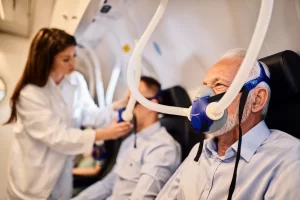You probably know that oxygen therapy is used for people with lung and respiratory diseases.
Hyperbaric oxygen therapy (HBOT) is different from oxygen therapy. Instead of using a mask or tube to deliver oxygen, hyperbaric oxygen therapy uses a pressurized chamber to deliver pure oxygen to your lungs.
The pressure inside the chamber is about 1.5-2.5 times higher than the normal air pressure around you. That elevated pressure creates an environment that lets your lungs absorb up to three times more oxygen.
As a leading wound specialist and hyperbaric doctor in San Antonio, Texas, Manjulatha Badam, MD, CWSP, UHM, uses hyperbaric oxygen therapy to treat an array of medical conditions, including slow-healing diabetic ulcers. Here, she explains how it could help you.
Diabetes and wound healing
As you may know, diabetes affects blood sugar (glucose) levels. But what you might not know is that diabetes can have a major effect on the way your body heals after an injury, particularly skin injuries on your feet and ankles.
Diabetes interferes with the way your body handles glucose, but it also causes a significant amount of inflammation. That inflammation damages the inside of your blood vessels, making them narrower and less flexible. As a result, it’s harder for blood to flow to your tissues and organs.
Blood flow is essential for wound healing. When you have an injury, the damaged area needs extra oxygen for healing. When circulation is diminished, your tissues don’t receive the amount of oxygen they need to support normal healing, so it takes a lot longer for those wounds to heal.
Slow-to-heal wounds are exposed to germs a lot longer than normal. Plus, poor circulation limits the number of germ-fighting white blood cells that reach the injury.
These factors, combined with other negative effects of inflammation, can allow germs to infect a wound quickly. In fact, diabetic ulcers are a leading cause of lower limb amputations.
Hyperbaric oxygen therapy and diabetic wound ulcers

HBOT is painless and noninvasive. During your session, you recline in a transparent hyperbaric chamber — a small room within a room. The chamber allows the pressure in that area to be slightly increased, and it also keeps the oxygen from floating away.
You may notice some sensations during your therapy. Many of our patients liken it to the sensation of taking off in an airplane — a mild lightheadedness that indicates the oxygen is being delivered through your circulatory system.
We monitor you throughout your therapy, and the transparent walls of the chamber allow you to see the rest of the room around you.
Multiple sessions for optimal benefits
By helping your body receive and absorb more oxygen than normal, HBOT supports better healing in multiple ways. Some of those benefits include:
- Decrease in damaging inflammation
- Improvement in blood vessel activity
- Development of new blood vessels
- Ramped-up production of proteins essential in tissue healing
- Increased production of stem cells to replace damaged cells
- Optimized delivery of white blood cells to battle infections
HBOT is a medical therapy, and before your initial treatment, we assess your health needs and review your medical history to determine the best therapy for your needs. Most people benefit from a series of 10-40 treatments, each of which takes about 60-110 minutes.
HBOT and radionecrosis treatment
Although HBOT is widely used to help heal diabetic ulcers, it has many other applications, too.
At our practice, we frequently use HBOT to treat patients with soft-tissue radionecrosis and osteo-radionecrosis (bone tissue death), two serious medical problems that can occur as a result of radiation exposure (including radiation therapy used in cancer treatment).
In these situations, HBOT delivers the extra oxygen those tissues need to help reduce damage and support healing and tissue health.
Get help for your slow-to-heal wounds
HBOT has been shown in clinical trials to be very effective in helping to treat diabetic foot ulcers, especially as an adjutant therapy used in combination with antibiotics and other treatments.
If you’re diabetic and you have a slow-to-heal wound, even a small delay in treatment could be all it takes for a serious infection to set in. Getting medical care right away prevents infections from occurring or spreading to deeper tissues.
To learn more about HBOT at Vayu Advanced Wound Clinic and Hyperbarics, call our San Antonio, Texas, office at 210-651-1112 or book an appointment online today.
FAQs
-
How long do the effects of hyperbaric oxygen therapy last?
The effects of hyperbaric oxygen therapy (HBOT) can vary depending on the condition being treated, the number of sessions, and individual response. For acute conditions, the benefits may last weeks to months, while for chronic conditions or wound healing, regular maintenance sessions might be needed to sustain results. It’s best to consult with a healthcare professional for personalized guidance.
-
How does hyperbaric oxygen treat ulcers?
Hyperbaric oxygen therapy (HBOT) enhances ulcer healing by increasing the oxygen concentration in blood and tissues. Patients breathe 100% oxygen in a pressurized chamber, which promotes faster cell regeneration, improves blood vessel formation (angiogenesis), reduces inflammation, and combats infection. This therapy is particularly effective for chronic or non-healing ulcers, such as diabetic foot ulcers or pressure sores, by creating an optimal environment for tissue repair.

